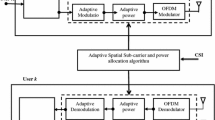Abstract
The traffic performance of integrated 3G wide-band code division multiple access (WCDMA) and GSM/GPRS network is evaluated. This type of network links two cellular radio systems which have different set of frequency bands and the same coverage size. The base station of 3G WCDMA is installed on an existing GSM/GPRS site. Dual-mode mobile terminals use handoff to establish calls on the better system. The soft handoff or inter-frequency hard handoff occurs when mobile terminals of 3G WCDMA or GSM/GPRS move between two adjacent cells, respectively. The inter-system hard handoffs are used between 3G WCDMA and GSM/GPRS systems. The data rate conversions between different systems, soft handoff region size, multiple data rate multimedia services, and the effect of the mobile terminal mobility on the user mean dwell time in each system are considered in the study. The simulation results demonstrate that a great traffic performance improvement on the complementary use of 3G WCDMA and GSM/GPRS cellular radio networks compared with the use of GSM/GPRS cellular radio networks. When high-data rate transmission is chosen for low-mobility subscribers, both the handoff failure probability, and carried traffic rates increase with the new call generation rate. However, both rates decrease conversely with the increasing new call generation rate as soon as the new call generation rate exceeds a critical value. This causes the integrated networks saturation. The higher mean speed for the mobile terminals produces lower new call blocking probabilities and total carried traffic. The new call blocking probabilities and total carried traffic increase with the size of the soft handoff region.
Similar content being viewed by others
References
Viterbi A.J. (1995). CDMA Principles of Spread Spectrum Communication. Addison-Wiesley, Reading, MA
ARIB IMT-2000 Study Committee, “Japan’s Proposal for Candidate Radio Transmission Technology on IMT-2000: W-CDMA”, ARIB, Japan 1998.
Yi-B. Lin and Ai-C. Pang, “Comparing Soft and Hard Handoffs”, IEEE Transactions on Vehicular Technology, Vol. 49, Issue: 3, pp. 792–798, 2000.
Holma H., Toskala A. (2000). WCDMA for UMTS: Radio Access for Third Generation Mobile Communications. Wiley, New York
R.P. Narrainen and F. Takawira, “Performance Analysis of Soft Handoff in CDMA Cellular Networks”, IEEE Transactions on Vehicular Technology, Vol. 50, No. 6, pp. 1507–1517, 2001.
J. O’Konek, “Dual Band Network Infrastructure”, in Proc. of 1998 Next Generation Wireless Commun. Seminar, 1998, pp. 253–280.
J. Mar and J.P. Huang, “Traffic Performance Analysis of Integrated Dual-Band Cellular Radio Networks”, IEE Proceedings on Communication, Vol. 147, pp. 180–186, 2000.
S.S. Rappaport, “Blocking, Hand-off and Traffic Performance for Cellular Communication System with Mixed Plat-forms”, IEE Proceedings, part I, Communication, Speech and Vision, Vol. 140, Issue: 5, pp. 389–401, 1993.
V.R. Kolavennu, S.S. Rappaport et al., “Traffic Performance Characterization of a Personal Radio Communication System”, Proceedings Institute Electronic Engineering, Vol. 133, part. F, pp. 550–561, 1986.
S.S. Rappaport, “The Multiple-call Handoff Problem in High Capacity Cellular Communication Systems”, Transactions on Vehicular Technology, Vol. 40, pp. 546–557, 1991.
M. Ylianttila, M. Pande, J. Makela, and P. Mahonen, “Optimization Scheme for Mobile Users Performing Vertical Handoffs between IEEE 802.11 and GPRS/EDGE Networks”, in Proc Global Telecommunications Conference, 2001. GLOBECOM ’01. IEEE, 2001, Vol. 6, pp. 3439–3443.
P. Lin and Yi-B. Lin, “Channel Allocation for GPRS”, Vehicular Technology, IEEE Transactions on, Vol. 50, No. 2, pp. 375–387, 2001.
F. Adachi, M. Sawahashi, and K. Okawa, “Tree-structured Generation of Orthogonal Spreading Codes with Different Lengths for Forward Link of DS-CDMA Mobile Radio”, IEE Electronic Letters Online, Vol. 33, No. 1, pp. 27–28, 1997.
D. Hong and S.S. Rappaport, “Traffic Model and Performance Analysis for Cellular Mobile Radiotelephone Systems with Prioritized and Nonprioritized Handoff Procedures”, IEEE Transactions on Vehicular Technology, Vol. VT-35, No. 3, pp. 77–92, 1986.
Y.B. Lin, “Impact of PCS Handoff Response Time”, IEEE Communication Letters, Vol. 1, pp. 160–162, 1997.
P. O’Reilly, Simulation with Visual SLAM and AweSim, New York: Wiley, 1999.
Author information
Authors and Affiliations
Corresponding author
Rights and permissions
About this article
Cite this article
Mar, J., Huang, J.P. The Complementary Use of 3G WCDMA and GSM/GPRS Cellular Radio Networks. Wireless Pers Commun 43, 511–531 (2007). https://doi.org/10.1007/s11277-007-9247-6
Received:
Accepted:
Published:
Issue Date:
DOI: https://doi.org/10.1007/s11277-007-9247-6




